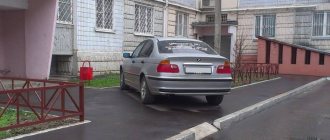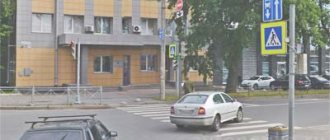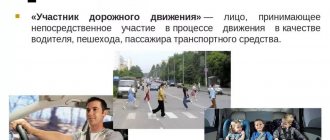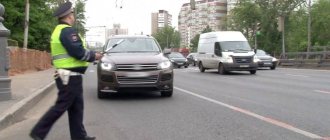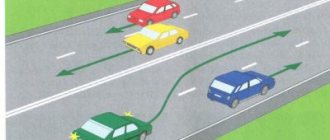Drivers must remember to comply with traffic rules, not only when driving their car, but also when leaving it in parking lots, parking lots, roads, etc. Particular attention should be paid to parking in the oncoming lane. Failure to comply with legal requirements regarding leaving a vehicle in this manner can lead to very unpleasant consequences for motorists in the form of a fine.
To avoid getting into trouble, motorists are encouraged to read the article about the rules for parking in the oncoming lane, as well as the penalties for violating them.
How to stop and park in oncoming traffic correctly
On the left side of the road, and therefore, in the presence of two-way traffic on the oncoming lane, according to clause 12.1 of the Russian Federation Traffic Regulations, it is allowed to stop and park exclusively in populated areas and only on those roads that have one lane each for the oncoming and oncoming directions. An essential condition for legal parking on oncoming traffic is the absence of tram tracks in the middle . In one-way traffic, the same rules apply for stopping and parking on the left as for parking on the right. However, vehicles whose weight exceeds 3.5 tons can stop only when unloading and loading are necessary (for example, bringing goods to a store, delivery service, etc.).
Clause 12.2 of the Russian Traffic Regulations covers the correct methods for parking a vehicle. It says that parking cars on the roads is only allowed in a parking lot parallel to the roadway and in one row . Only two-wheeled vehicles that do not have a side trailer are allowed to park in two rows. In another way, that is, at an angle to the roadway, parking can only be done if there is a permitting road sign depicting the method of parking the vehicle and road markings provided for this section of the road. In addition, the parameters of the roadway section must allow the vehicle to be parked in this way. It stands for parking; if there are no signs specifying how to park the vehicle, the car should only be parked parallel to the roadway, otherwise the rules will be violated.
For cars, motorcycles, mopeds and bicycles, parking may also be permitted on the edge of the sidewalk bordering the roadway, but only if a “Parking” road sign is installed in this place together with one of the signs depicting the permitted method performing a maneuver.
Read more about parking at the pedestrian crossing by following the link.
Additional chapters:
- SDA (traffic rules) of the Russian Federation 2020
- Road signs
- Road markings and their characteristics
- Basic provisions for the admission of vehicles to operation and the responsibilities of officials to ensure road safety
- List of faults and conditions under which the operation of vehicles is prohibited
- Administrative and criminal liability for violation of traffic rules
- Some articles of the Code of the Russian Federation on administrative offenses
- Article 264 of the Criminal Code of the Russian Federation
12.1. Stopping and parking of vehicles is permitted on the right side of the road on the side of the road, and in its absence - on the roadway at its edge and in the cases established by paragraph 12.2 of the Rules - on the sidewalk.
On the left side of the road, stopping and parking are permitted in populated areas on roads with one lane for each direction without tram tracks in the middle and on one-way roads (trucks with a permissible maximum weight of more than 3.5 tons are allowed on the left side of one-way roads only stopping for loading or unloading).
The driver of a motorcycle violated the rules of stopping because he did not pull over to the side of the road, and the driver of a car violated the rules of stopping because he drove into the oncoming lane to stop. | Since you are in a populated area, parking on the left side of the road, at location A, is permitted. In addition, parking is permitted behind the “No Stopping” sign with a sign indicating the end of the sign’s coverage area (place B). Parking in place B, in front of this sign, is prohibited |
Since there is a shoulder on the right, the drivers of cars B and C violated the Rules by stopping on the roadway | The parking ban applies in the place where the “No Parking” sign with the “Validity Area” sign is installed. Behind the sign you have the right to park your car (place A). Parking in location B is prohibited because the driver did not pull over to the side of the road. |
Stopping is allowed only in the place marked with the letter B: on the side of the road on the right | The place where you plan to stay is located within the boundaries of a populated area. You can park the car at any of the points (A, B or C) |
| Stopping is prohibited along trajectory B (roadway) and along trajectory A (it is prohibited to enter the leftmost lane of such a road). On the right side of the road on the side of the road (trajectory B), stopping is allowed |
12.2. It is allowed to park a vehicle in one row parallel to the edge of the roadway, with the exception of those places where the configuration (local widening of the roadway) allows for a different arrangement of vehicles. Two-wheeled vehicles without a side trailer may be parked in two rows.
| In this situation (presence of local widening of the roadway), parking rules are not violated |
Parking on the edge of the sidewalk bordering the roadway is permitted only for cars, motorcycles, mopeds and bicycles in places marked with sign 6.4 with one of the signs 8.6.2, 8.6.3, 8.6.6 - 8.6.9.
Since there is no sign permitting parking, both cars violate the Rules | You can park your car or motorcycle behind this sign. Truck parking is prohibited here |
| The driver of car B violates the Rules by disobeying the instructions of the “Parking Place” sign with the sign “Method of parking a vehicle” |
12.3. Parking for the purpose of long-term rest, overnight stay, etc. outside a populated area is permitted only in designated areas or off the road.
| The “Rest Place” service sign informs you that after 500 m there is a rest area where you can park your car for a long time |
12.4. Stopping is prohibited:
- on tram tracks, as well as in the immediate vicinity of them, if this creates interference with the movement of trams;
- at railway crossings, in tunnels, as well as on overpasses, bridges, overpasses (if there are less than three lanes for traffic in a given direction) and under them;
You cannot stop to pick up a passenger: you are on a bridge, and there are only two lanes for traffic in this direction | You cannot stop to pick up a passenger because stopping is prohibited in the tunnel you are in. |
| This road has three lanes for traffic in one direction. Therefore, stopping at the indicated place is permitted |
- in places where the distance between a solid marking line (except indicating the edge of the roadway), a dividing strip or the opposite edge of the roadway and a stopped vehicle is less than 3 m;
| On this section of the road, the distance between the solid marking line and a stopped car and motorcycle is less than 3 m. Stopping is prohibited |
- at pedestrian crossings and closer than 5 m in front of them;
In the indicated place behind the pedestrian crossing you can stop without violating the Rules | In the indicated place behind the pedestrian crossing you can stop without violating the Rules |
- on the roadway near dangerous turns and convex breaks in the longitudinal profile of the road when the visibility of the road is less than 100 m in at least one direction;
| Parking in the indicated place is permitted, since you will park the car not on the roadway, but on the side of the road |
- at the intersection of roadways and closer than 5 m from the edge of the roadway being crossed, with the exception of the side opposite the side passage of three-way intersections (crossroads) that have a continuous marking line or dividing strip;
At a roundabout, you can stop more than 5 m from the intersection, as shown in the figure. | The indicated trajectory involves stopping your car in front of a three-way intersection, which is permitted only if there are continuous markings or a dividing strip. This illustration shows solid and (on your side) broken marking lines. Therefore, you are prohibited from stopping at the indicated location at the intersection. |
| The truck driver violated the Rules by stopping at a distance of less than 3 m from the solid marking line. Stopping a car does not violate the Rules |
- closer than 15 meters from the stopping places of fixed-route vehicles or parking for passenger taxis, indicated by marking 1.17, and in its absence - from the sign of the stopping place of fixed-route vehicles or parking for passenger taxis (except for stops for boarding and disembarking passengers, if this does not interfere with the movement of fixed-route vehicles vehicles or vehicles used as passenger taxis);
In front of you are stopping places for route vehicles (pay attention to the markings and signs). You can stop only to pick up or unload a passenger, if this does not interfere with the movement of route vehicles | In front of you are stopping places for route vehicles (pay attention to the sign). You can stop only to pick up or unload a passenger, if this does not interfere with the movement of route vehicles |
- in places where the vehicle will block traffic lights, road signs from other drivers, or make it impossible for other vehicles to move (enter or exit), or interfere with the movement of pedestrians.
| You are not allowed to stop at the indicated place, because this will interfere with the movement of a passenger car |
12.5. Parking is prohibited:
- in places where stopping is prohibited;
| The “No Stopping” sign is supplemented by a “Validity Area” sign. This is where the stop ban ends. Further, after the sign, you can stop |
- outside populated areas on the carriageway of roads marked with sign 2.1;
| You are on the main road. If, due to the insufficient width of the shoulder, you cannot remove the car from the roadway, parking in the indicated place is prohibited |
- closer than 50 m from railway crossings.
Parking of both cars (A and B) is prohibited, since the distance to the railway crossing is less than 50 m | Both cars (A and B) can stop (but not park) at a specified distance from the railway crossing |
12.6. If forced to stop in places where stopping is prohibited, the driver must take all possible measures to remove the vehicle from these places.
12.7. It is prohibited to open vehicle doors if this will interfere with other road users.
12.8. The driver may leave his seat or leave the vehicle if he has taken the necessary measures to prevent spontaneous movement of the vehicle or its use in the absence of the driver.
When leaving your vehicle, be sure to set the parking brake and close the doors. | When leaving your vehicle, be sure to set the parking brake and close the doors. |
Next: section “Navigation of intersections” >>
In what cases is a maneuver prohibited and what penalties are provided for this?
| Type of offense | Sanction | Rule of law |
| Violation of the rules for stopping and parking a vehicle without qualifying signs. | A warning or a fine of 500 rubles. | Part 5 art. 12.19 Code of Administrative Offenses of the Russian Federation |
| Stopping and parking at railway crossings. | Punishable by a fine of 1000 rubles or deprivation of rights for a period of 3 to 6 months. For committing the same offense again, a driver's license will be suspended for 1 year. | Part 1 art. 12.10 Code of Administrative Offenses of the Russian Federation |
| Parking and stopping in parking spaces provided for disabled vehicles, committed by drivers who do not belong to the category of citizens with disabilities. | Punishable by a fine of 5,000 rubles. | Part 2 art. 12.19 Code of Administrative Offenses of the Russian Federation |
| Stopping and parking a vehicle at a distance of less than 5 meters from or on a pedestrian crossing, as well as violating the rules for parking on sidewalks. | For such an administrative offense you will have to pay 1000 rubles. | Part 3 art. 12.19 Code of Administrative Offenses of the Russian Federation |
| Parking in places designated for stopping route vehicles or passenger taxis, as well as at a distance of less than 15 meters from them. Picking up and disembarking passengers is an exception and is therefore not an offence. | The fine is 1000 rubles. | Part 3.1 art. 12.19 Code of Administrative Offenses of the Russian Federation |
| Stopping and parking on tram tracks, as well as parking of vehicles further than the first row from the edge of the roadway. | Violation of this rule will result in a fine of 1,500 rubles. | Part 3.2 art. 12.19 Code of Administrative Offenses of the Russian Federation |
| Parking on the roadway in violation of the rules, as a result of which obstacles are created for other road users. | Incurs a fine of 2,000 rubles. | Part 4 art. 12.19 Code of Administrative Offenses of the Russian Federation |
The listed fines apply throughout the country, but for some exceptions are made in the cities of Moscow and St. Petersburg.
Thus, on the basis of Part 5 of Art. 12.19 The fine for parking without qualifying signs is 2,500 rubles.
In accordance with Part 6 of Art. 12.19 of the Code of Administrative Offenses of the Russian Federation, the amount of the fine in these cities has been increased to 3,000 rubles. for the following offences:
- parking on a pedestrian crossing or at a distance closer than 5 meters to it, as well as violating the rules of stopping and parking on sidewalks;
- parking at stops for route vehicles and passenger taxis or at a distance of less than 15 meters to them;
- parking on tram tracks or further than the first row from the edge of the roadway;
- creating obstacles for other traffic participants with an incorrectly parked vehicle.
Is it possible to stop on the side of oncoming traffic outside the city?
Outside the city, stopping on the side of oncoming traffic is prohibited. This rule follows from clause 12.1 of the Russian Traffic Regulations, since it states that stopping and parking on the left side is allowed only in populated areas.
If the need to stop on the side of the road in the opposite direction is great, you can turn around (provided that the median strip allows this maneuver) and stop in accordance with all the rules.

